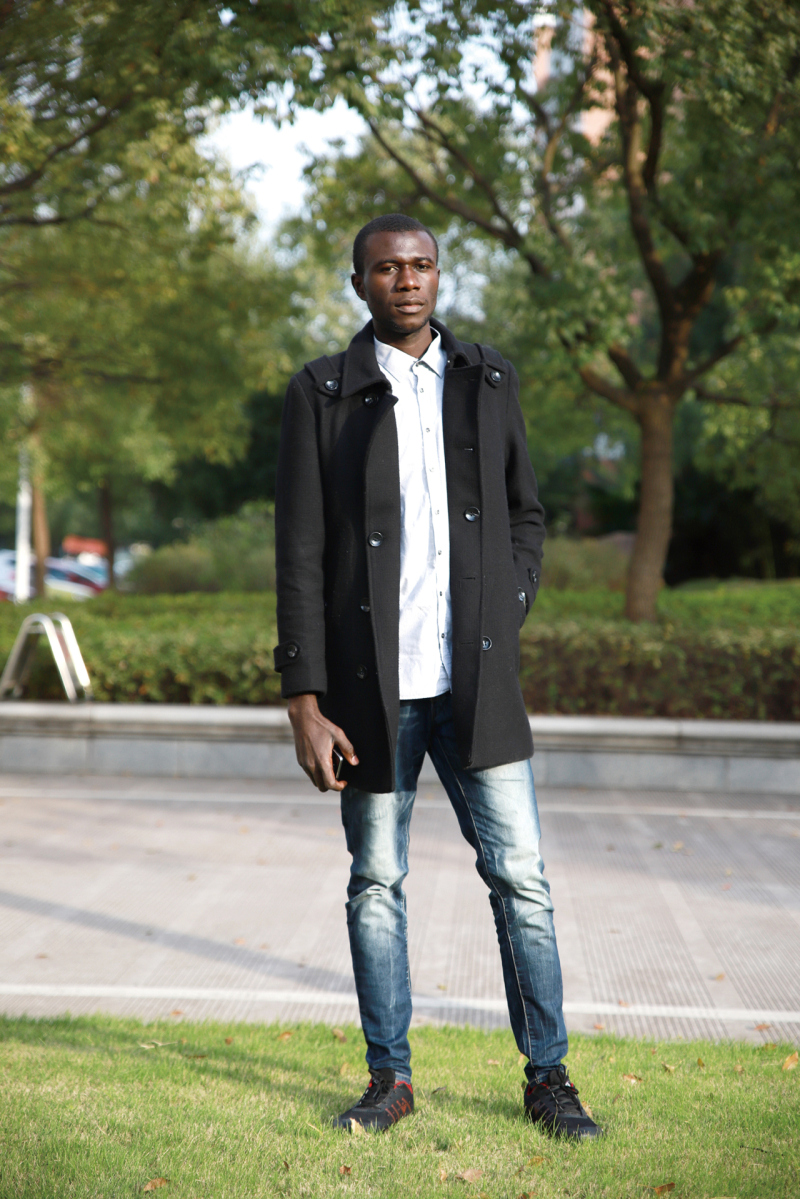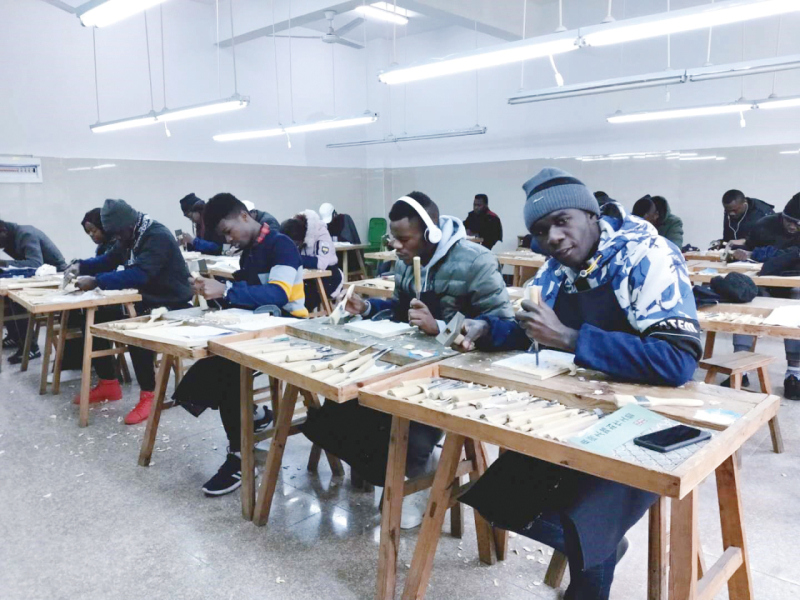In October 2018, Onanga Jolga Gedeon, a 24-year-old Congo lad, went all the way to take a training course of woodcarving in Dongyang city, Zhejiang province, where he and 20 other students were about to start a new chapter in their life. That was also the first time in Zhejiang that woodcarving training cources had been opened to international students.

Onanga Jolga Gedeon, aka Tong Xiaodong.
Now Onanga often eats late-night street barbecue as Chinese locals do, and visits scenic spots where he can study the collection of woodcarving art pieces. Having mastered some basic techniques already, this 6-feet-tall Mr. Sunshine dreams about interpreting his local culture through his own piece of woodcarving one day and becoming a bridge of culture and friendship between China and Africa.
Although he has never been to China before 2018, Onanga has always been curious about this country. "In the Republic of Congo, many Chinese have helped my country do a lot of things, so I really want to go to China."
As a newcomer, he had to learn Chinese first. However, just like most foreigners, he found the language quite difficult even after taking a one-year preparatory course. How to distinguish tones alone has given him the biggest headache.
Thanks to the help of his Chinese language partner, Onanga successfully passed the Chinese Proficiency Level 3 exam last year and also grew familiar with a lot of professional words related to knives and engraving. His Chinese partner also gave Onanga a Chinese name, Tong Xiaodong, after his own family name (Tong), as the two of them getting closer.

Onanga Jolga Gedeon loves the local night market.
On the weekends, Tong Xiaodong and his classmates always go sight-seeing and shopping in the surrounding night markets and tourist attractions on their electric motorcycles. "Could we have five skewers of barbecued pork ... and a fried rice, please?" For the international students who used to have cassava as their staple food, eating barbecues in the night market on Zhenxing Road is quite a new experience. So is the view near Donghyeonbong Park, where they have been really impressed by the beautiful houses at the foot of the mountains and the artistic auditorium when jogging on the trails. "I hope that in the future, my hometown will turn out just like this," Tong Xiaodong said.
He always travels to different parts of Zhejiang to experience local customs and traditions whenever he has time. In the Spring Festival in 2019, he was invited to come to the house of his Chinese partner in Ninghai county, Ningbo city. There, he was warmly welcomed by the host family and his friends. Everyone in the house was busy posting spring couplets, hanging Chinese knots and giving New Year's greetings to each other, which made him feel so warm. "They invited me to sit with them, eating dinner, chatting ... and I felt as relaxed and happy as if I were in my own home."
During the period, the family also took Tong Xiaodong out with them to visit the temple fair, go holiday shopping and watch festival performances. In the ancient town of Qiantong, he was not only enchanted by the ancient houses of the Ming (1368-1644) and Qing dynasties, but also attracted by the tasty sesame candies and wheat cakes.

During the sports meeting in his school, the international students team that Onanga Jolga Gedeon was part of won good results.
During the summer of 2019, the woodcarving class took him to Shengzhou, another city in Zhejiang, and he enjoyed a bowl of local fried rice cakes, which he found amazing. "The rice cakes have egg, meat and tofu in it, and they taste really delicious!"
"In my hometown, woodcarving is an ancient craft." After coming to Dongyang, Tong Xiaodong found that compared to the African style, which is less sophisticated, but seems more exaggerated and dynamic, the Chinese style is much richer in shape and content, and much more refined in terms of techniques. Yet both are able to express people's love for life.
Before learning woodcarving, Tong Xiaodong took a special visit to the China Woodcarving Museum and some other sites to learn about the culture behind woodcarving. At the museum, he was surprised to find woodcarvings from Africa: "Chinese people not only value their own traditional art, they also preserve the world woodcarving culture as a whole." During this year's National Day holiday, he visited the Lu Residence together with his classmates. Walking around the ancient complex built 600 years ago, they were incredibly impressed by the exquisite and ornate masterpieces of woodcarving: "It's no different from where the kings lived!"
From organizing tools, to designing and picking materials, and carving the basic patterns ... the skills of woodcarving gradually presented themselves in front of Tong Xiaodong, who has been learning to master them for over a year.
"At first it is both interesting and difficult ... like carving a plum blossom, you need to carve so many times before finally getting only an outline." Tong Xiaodong smiled and paused for two seconds, "In addition to techniques, patience is also very important." On his fingers there are some tiny scars, a faithful record of his loneliness every day and night.
"Xiaodong is very gifted," according to Du Feidong, the instructor. His "foreign disciple" is cheerful, eager to learn, and has a good understanding of the craft.

Onanga Jolga Gedeon asks his instructor a question on woodcarving.
For a while, Mr. Du has been asking the students to try to understand the technique of landscape carving. When first looking at the drawing, Tong Xiaodong was a bit confused: how to show the three-dimensional sense of the high and low mountains?
Mr. Du pointed to the high point of the pattern: "Xiaodong, you may want to understand the drawing first, and then think about how to run the knife according to the shape to show the depth of the pattern."
When he began to carve, Xiaodong was very worried that he would not be able to recover the whole pattern if he made a mistake, and within a few minutes he was sweating profusely. Seeing what was happening, Mr. Du encouraged him to be bold and careful at the same time. "When you make up your mind, just do it with a clear picture in mind. Hold the knife straight and tight, keep your hand steady, so that the knife can be pushed accurately. And remember, you do one cut at a time."
Following the instructions of Mr. Du, Tong Xiaodong repeated this set of moves every day, and slowly mastered the knife-carving skills.
"The woodcarving here requires more than a dozen processes to complete, a complex craft not often seen in my country," he said. Located in central and western Africa, the Republic of Congo has a developed forestry industry and a profound culture, and it is Tong Xiaodong's goal to deliver his home culture vividly and innovatively through Dongyang woodcarving techniques. "In my hometown, besides the mother river Congo, there is a famous bridge (La Corniche) and a famous church (Sainte-Anne Basilica). In the future I hope to combine the three to create woodcarvings that showcase our country's style — especially the bridge, which I hope to turn into a bridge of culture and friendship connecting China and Africa."
Editor: Li Qiaoqiao





